Relation between Russian Universities and Regional Innovation Development
Abstract
1. Introduction
2. Theoretical Framework of the Study
2.1. University Efficiency
2.2. Universities as Drivers of Innovative Regional Development
2.3. Universities and Entrepreneurship Collaboration as a Factor of Innovative Regional Development
- Development and implementation of joint educational programs;
- Part-time or full-time business representatives at the university and university in business (job change or double employment).
- Industrial traineeships and internships for students;
- Use of university facilities by business (experimental facilities, infrastructure);
- Holding and participation in scientific conferences.
- Joint scientific publications;
- Contract research.
- Joint research and publications;
- Provision of consulting services;
- Exchange of professional information through communication platforms (workshops, exhibitions);
- Interaction within clusters and technological platforms.
- Creation of start-up and spin-off companies (any companies having affiliation or interaction with the university);
- Transfer of intellectual rights (licensing);
- Small-scale production.
- Mentoring, tutoring, conducting master classes, business trainings on the development of entrepreneurial skills of students and university staff;
- Additional education, advanced training;
- Scholarships, venture financing of projects.
3. Data and Research Methodology
3.1. DEA Method
- X is input
- Y is output
- ϕ is a calculated variable for each object, taking a value from 0 to 1
- λ is a vector of constants of dimension for a model matrix
- are the projection of objects that do not lie on the boundary of efficiency to the boundary of efficiency
3.2. Analysis Specification
4. Results
5. Discussion: The Open Innovation by Universities in Regional Innovation System
6. Conclusions
Author Contributions
Funding
Acknowledgments
Conflicts of Interest
Appendix A
| DMU | n/HEI_11 | n/bHEI_11 | n/teach_11 | n/stu_11 | n/grad_11 | n/research_11 | research_11 | GRP_18 | innact_18 | vol inn_18 | patent_18 | research_11 | educ_18 |
|---|---|---|---|---|---|---|---|---|---|---|---|---|---|
| Belgorod region | 7 | 14 | 3202 | 77.7 | 14.6 | 309 | 1921.1 | 470,874.3 | 14.8 | 101,169.6 | 54.83871 | 1921.1 | 2.5 |
| Bryansk region | 5 | 20 | 2030 | 57.2 | 11.4 | 50 | 977.7 | 233,701 | 6.2 | 12,198.6 | 235 | 977.7 | 3.6 |
| Vladimir region | 7 | 17 | 2021 | 53.6 | 11.3 | 286 | 5391.3 | 281,366.9 | 9 | 34,029.9 | 11.24031 | 5391.3 | 2.9 |
| Voronezh region | 22 | 20 | 7759 | 133.2 | 28.2 | 919 | 8164.5 | 360,418.2 | 11.7 | 32,481.8 | 28.04348 | 8164.5 | 3.6 |
| Ivanovo region | 9 | 10 | 2618 | 49 | 11.6 | 259 | 585.7 | 174,995.3 | 4.2 | 219.2 | 10.05025 | 585.7 | 5 |
| Kaluga region | 4 | 24 | 1694 | 37.6 | 8 | 940 | 6070.9 | 368,913.4 | 9 | 16,574.3 | 39.44954 | 6070.9 | 3.1 |
| Kostroma region | 3 | 4 | 1214 | 21.7 | 4.1 | 21 | 130.8 | 247,313.7 | 2.8 | 14,590.9 | 31.42857 | 130.8 | 4.6 |
| Kursk region | 11 | 13 | 2783 | 72.3 | 16.3 | 144 | 5936.1 | 325,114.5 | 5 | 30,361 | 21.59091 | 5936.1 | 4 |
| Lipetsk region | 6 | 16 | 1788 | 41.6 | 7.9 | 100 | 291.1 | 406,726.2 | 18.5 | 63,108.2 | 29.78723 | 291.1 | 2.6 |
| Moscow region | 32 | 127 | 6464 | 168.4 | 33.3 | 8600 | 119,715.9 | 483,683.3 | 8.9 | 384,328.6 | 38.85794 | 119,715.9 | 2.9 |
| Oryol Region | 7 | 6 | 2486 | 43.2 | 9 | 171 | 976.4 | 282,494.1 | 6.8 | 1428.8 | 40.35088 | 976.4 | 5.6 |
| Ryazan Oblast | 9 | 15 | 2839 | 54.6 | 9.6 | 174 | 1594.4 | 298,624 | 12.1 | 19,887.4 | 75 | 1594.4 | 4.2 |
| Smolensk region | 7 | 27 | 2026 | 48.2 | 9 | 64 | 1604.5 | 274,415.3 | 6.5 | 10,137.5 | 46.34146 | 1604.5 | 4.2 |
| Tambov Region | 6 | 11 | 2010 | 42.2 | 8.9 | 179 | 1079.2 | 297,933.7 | 11 | 12,962.6 | 31.76471 | 1079.2 | 3.2 |
| Tver region | 8 | 28 | 2193 | 42.8 | 8.4 | 462 | 4644.3 | 276,255.4 | 8.7 | 10,053.9 | 48.55072 | 4644.3 | 3.9 |
| Tula region | 8 | 17 | 2140 | 52.3 | 9.6 | 178 | 5974.9 | 344,487.4 | 9.2 | 80,875.4 | 24.58101 | 5974.9 | 2.9 |
| Yaroslavskaya oblast | 9 | 25 | 2621 | 52.2 | 10.3 | 884 | 6938.5 | 369,539.9 | 8.3 | 46,557.6 | 64.42953 | 6938.5 | 3.4 |
| Moscow | 268 | 6 | 63,452 | 1168.1 | 271.9 | 47,373 | 358,214.8 | 115,7373 | 14.3 | 248,998.8 | 31.8711 | 358,214.8 | 2.1 |
| Republic of Karelia | 3 | 11 | 1397 | 23.6 | 4.6 | 314 | 943.2 | 371,452 | 5.9 | 559.9 | 144.4444 | 943.2 | 3.8 |
| Komi Republic | 5 | 13 | 1108 | 33.8 | 6 | 435 | 2350 | 640,622.9 | 3.5 | 1931.9 | 10 | 2350 | 3.1 |
| Nenets Autonomous Okrug | 0 | 0 | 0 | 0 | 0 | 1 | 21.5 | 5,821,559.8 | 4.6 | 18 | 0 | 21.5 | 0.8 |
| Arkhangelsk region | 6 | 15 | 1975 | 42.2 | 9 | 150 | 1522.9 | 379,976.5 | 4.4 | 99,183.9 | 55.35714 | 1522.9 | 2.9 |
| Vologodskaya Oblast | 6 | 17 | 1776 | 38.4 | 9.4 | 72 | 479.5 | 410,037.4 | 5.4 | 17,869.4 | 40.625 | 479.5 | 2.1 |
| Kaliningrad region | 8 | 20 | 1838 | 29.5 | 7.6 | 116 | 1094 | 390,359.4 | 4.3 | 1244.4 | 45.65217 | 1094 | 3.1 |
| Leningrad region | 3 | 32 | 527 | 14.8 | 2.2 | 579 | 6863.5 | 511,836.5 | 9.3 | 22,072.5 | 90.47619 | 6863.5 | 2 |
| Murmansk region | 4 | 24 | 1100 | 22.1 | 7 | 489 | 2276.1 | 560,380.2 | 8.2 | 3083.8 | 22.85714 | 2276.1 | 3.2 |
| Novgorod region | 1 | 10 | 1001 | 18.4 | 3.9 | 27 | 2751.8 | 398,141 | 8.8 | 7467.4 | 34.09091 | 2751.8 | 3.1 |
| Pskov region | 5 | 14 | 1003 | 21.8 | 4.2 | 70 | 437.7 | 224,152.4 | 7.4 | 2222.1 | 80 | 437.7 | 3.8 |
| Saint Petersburg | 90 | 9 | 28,592 | 374.9 | 93.2 | 11,285 | 120,804 | 712,303.6 | 16.1 | 303,112.4 | 64.63335 | 120,804 | 3.6 |
| Republic of Adygea | 2 | 7 | 1104 | 19.5 | 4 | 71 | 241.3 | 201,918.1 | 6.3 | 3386.6 | 333.3333 | 241.3 | 5.1 |
| Republic of Kalmykia | 1 | 7 | 541 | 13.1 | 2.4 | 74 | 67.8 | 201,406.9 | 2.5 | 40.9 | 12 | 67.8 | 5.6 |
| Republic of Crimea | 0 | 0 | 0 | 0 | 0 | 0 | 1487.7 | 165,433.8 | 3.8 | 1404.7 | 191.6667 | 1487.7 | 4.5 |
| Krasnodar region | 34 | 83 | 8694 | 186.2 | 39.4 | 1039 | 5422 | 363,731.3 | 12.2 | 168,605.9 | 26.24357 | 5422 | 3.2 |
| Astrakhan region | 6 | 17 | 2334 | 44.7 | 7.1 | 202 | 549.4 | 332,447.4 | 7.7 | 696.1 | 22.53521 | 549.4 | 3 |
| Volgograd region | 16 | 26 | 6410 | 112.4 | 25.4 | 424 | 3547.6 | 292,565.7 | 4.6 | 25,053.7 | 67.02899 | 3547.6 | 3.6 |
| Rostov region | 26 | 61 | 10,805 | 210 | 43.4 | 1335 | 13,102.3 | 300,186.2 | 8.2 | 104,538.5 | 24.13249 | 13,102.3 | 3.1 |
| Sevastopol | 0 | 0 | 0 | 0 | 0 | 0 | 813.8 | 151,862.7 | 3.2 | 725.5 | 53.125 | 813.8 | 3.4 |
| The Republic of Dagestan | 18 | 40 | 6049 | 108.1 | 22.2 | 516 | 914.1 | 197,141 | 2.8 | 182 | 12.05674 | 914.1 | 4.8 |
| The Republic of Ingushetia | 2 | 1 | 587 | 11.9 | 2.1 | 32 | 62.1 | 106,756.6 | 4.8 | 22.8 | 0 | 62.1 | 9.9 |
| Kabardino-Balkarian Republic | 4 | 7 | 1547 | 28.1 | 5.7 | 276 | 654.5 | 153,710.9 | 3.8 | 307.1 | 22.58065 | 654.5 | 7.1 |
| Karachay-Cherkess Republic | 2 | 12 | 1136 | 16.9 | 3.2 | 134 | 510.3 | 156,602.4 | 1.8 | 40.9 | 50 | 510.3 | 6.1 |
| Republic of North Ossetia—Alania | 13 | 1 | 2313 | 33.9 | 6.7 | 190 | 343.4 | 178,390.3 | 4 | 26.4 | 10.11236 | 343.4 | 7.1 |
| Chechen Republic | 3 | 1 | 1676 | 33.4 | 5.3 | 243 | 269.3 | 118,696.4 | 0.2 | 576.4 | 17.64706 | 269.3 | 11.5 |
| Stavropol region | 23 | 55 | 6326 | 134.5 | 29.7 | 486 | 1855.3 | 232,582 | 5.2 | 33,566.7 | 29.13907 | 1855.3 | 3.9 |
| Republic of Bashkortostan | 15 | 42 | 7605 | 169 | 32.6 | 32.6 | 8813 | 330,389.3 | 7.4 | 109,688.9 | 28.28439 | 8813 | 4.1 |
| Mari El Republic | 3 | 7 | 1471 | 29.9 | 5.8 | 5.8 | 199 | 234,160 | 7.1 | 14,926.4 | 43.02326 | 199 | 3.5 |
| The Republic of Mordovia | 3 | 5 | 2181 | 41.4 | 9 | 9 | 828.8 | 245,214.7 | 12.5 | 52,414.7 | 72.91667 | 828.8 | 4.1 |
| Republic of Tatarstan | 33 | 55 | 10,382 | 209.6 | 45.2 | 45.2 | 16,221.4 | 499,778.6 | 22.2 | 435,557.7 | 48.19103 | 16,221.4 | 2.8 |
| Udmurt republic | 9 | 18 | 3786 | 73.3 | 15.9 | 15.9 | 1768.5 | 356,042.7 | 6.7 | 57,346.6 | 60.71429 | 1768.5 | 3.3 |
| Chuvash Republic | 6 | 20 | 2780 | 68.2 | 14.9 | 14.9 | 2034.6 | 211,587.6 | 24.7 | 23,011.4 | 49.07407 | 2034.6 | 4.1 |
| Perm region | 16 | 22 | 4648 | 102.4 | 18.9 | 18.9 | 14,334.3 | 414,418.5 | 6.4 | 221,164.2 | 35.58282 | 14,334.3 | 2.9 |
| Kirov region | 7 | 22 | 2127 | 54.2 | 11.4 | 11.4 | 2157.5 | 224,776 | 9.5 | 13,526.9 | 74.71264 | 2157.5 | 4.2 |
| Nizhny Novgorod Region | 17 | 29 | 7581 | 166.8 | 40.4 | 40.4 | 76,190.6 | 363,327.8 | 11.1 | 218,802.1 | 41.91781 | 76,190.6 | 3.1 |
| Orenburg region | 9 | 26 | 3744 | 81.1 | 16.1 | 16.1 | 1065.7 | 387,570 | 6.4 | 23,250.7 | 15.88785 | 1065.7 | 2.8 |
| Penza region | 5 | 15 | 2691 | 59 | 10.7 | 10.7 | 5461 | 251,717.5 | 20.7 | 20,845.5 | 32.83582 | 5461 | 3.6 |
| Samara Region | 29 | 31 | 7972 | 162.3 | 33.9 | 33.9 | 14,246.9 | 397,857.2 | 4.3 | 209,373.9 | 64.11483 | 14,246.9 | 3 |
| Saratov region | 11 | 23 | 6313 | 121.4 | 24.8 | 24.8 | 4464 | 263,773.6 | 5 | 10,348.8 | 59.90783 | 4464 | 3.7 |
| Ulyanovsk region | 5 | 12 | 2640 | 57.3 | 11.4 | 11.4 | 13,688.4 | 261,500.3 | 3.4 | 35,382.4 | 73.09417 | 13,688.4 | 4.4 |
| Kurgan region | 4 | 8 | 1204 | 37.7 | 7.6 | 7.6 | 346.7 | 225,984.4 | 4.6 | 4665.4 | 47.45763 | 346.7 | 4.7 |
| Sverdlovsk region | 32 | 54 | 9408 | 204.2 | 42.3 | 42.3 | 32,186.3 | 456,860.2 | 9.6 | 193,672.4 | 60.33403 | 32,186.3 | 3 |
| Tyumen region | 18 | 83 | 5537 | 154.3 | 31.1 | 31.1 | 16,373.6 | 1,627,945.9 | 7.9 | 206,025.7 | 46.32035 | 16,373.6 | 1.6 |
| Khanty-Mansi Autonomous Okrug—Ugra | 8 | 41 | 1678 | 46 | 6.5 | 6.5 | 3045.1 | 1,852,318.3 | 5.4 | 18,931.3 | 45.94595 | 3045.1 | 1.6 |
| Yamal-Nenets Autonomous Okrug | 0 | 25 | 206 | 11.6 | 0.8 | 0.8 | 173.6 | 3,670,257.6 | 7 | 212.3 | 26.82927 | 173.6 | 0.9 |
| Chelyabinsk region | 19 | 35 | 7160 | 181.2 | 32.8 | 32.8 | 22,381.1 | 360,048.1 | 8.6 | 103,405.8 | 67.11864 | 22,381.1 | 3.3 |
| Altai Republic | 1 | 1 | 321 | 5.3 | 1 | 1 | 92.9 | 213,474.3 | 68 | 75.7 | 0 | 92.9 | 8.9 |
| The Republic of Buryatia | 5 | 12 | 2161 | 48.2 | 102 | 10.2 | 869.6 | 202,627.8 | 4.7 | 2444.3 | 13.46154 | 869.6 | 7 |
| Tyva Republic | 0 | 4 | 307 | 6.2 | 1 | 1 | 261.2 | 164,687 | 1.8 | 34 | 0 | 261.2 | 12.4 |
| The Republic of Khakassia | 2 | 5 | 547 | 17.6 | 3.9 | 3.9 | 89.5 | 339,586 | 4 | 991 | 25 | 89.5 | 3.8 |
| Altai region | 10 | 22 | 4220 | 88.5 | 17.8 | 17.8 | 1754 | 210,350.7 | 12.6 | 14,546.2 | 55.97015 | 1754 | 4.1 |
| Transbaikal region | 4 | 9 | 1703 | 41.4 | 7.5 | 7.5 | 404 | 243,110.4 | 2.9 | 2110.4 | 13.33333 | 404 | 6.2 |
| Krasnoyarsk region | 12 | 36 | 6857 | 121.8 | 22.5 | 22.5 | 16,157.7 | 615,803.9 | 7.1 | 63,160.7 | 39.38356 | 16,157.7 | 3 |
| Irkutsk region | 15 | 22 | 5249 | 123.5 | 27.2 | 27.2 | 4210.8 | 443,297.8 | 5.3 | 7618 | 39.24731 | 4210.8 | 3.3 |
| Kemerovo region | 12 | 32 | 4563 | 96.9 | 18.1 | 18.1 | 2206.6 | 316,263.9 | 6.2 | 25,217 | 34.61538 | 2206.6 | 3.5 |
| Novosibirsk region | 25 | 16 | 7128 | 153.7 | 32.3 | 32.3 | 21,629.3 | 391,438.4 | 7.5 | 45,335.7 | 32 | 21,629.3 | 4 |
| Omsk region | 19 | 14 | 5188 | 106.1 | 21 | 21 | 6040.1 | 316,828.5 | 7.5 | 25,079.1 | 51.62791 | 6040.1 | 3.9 |
| Tomsk region | 9 | 10 | 5286 | 81.9 | 17.7 | 17.7 | 14,076.9 | 451,823.9 | 14 | 19,806 | 27.46114 | 14,076.9 | 4.4 |
| The Republic of Sakha (Yakutia) | 9 | 23 | 1946 | 47.2 | 6.7 | 6.7 | 2558.1 | 903,611.1 | 7.9 | 7537 | 54.23729 | 2558.1 | 4.4 |
| Kamchatka Krai | 3 | 7 | 483 | 16.4 | 3 | 3 | 1205.6 | 628,114.2 | 11.9 | 1303.1 | 85.71429 | 1205.6 | 4.8 |
| Primorsky Krai | 13 | 31 | 5485 | 95 | 17 | 17 | 6930.7 | 382,586.9 | 4.5 | 1560.7 | 25.88832 | 6930.7 | 3.1 |
| Khabarovsk region | 17 | 11 | 3703 | 84.5 | 17.8 | 17.8 | 5898 | 478,030.8 | 7.9 | 73,957.9 | 27.97203 | 5898 | 4.1 |
| Amurskaya Oblast | 5 | 6 | 1632 | 29.2 | 5.5 | 5.5 | 0 | 357,829 | 6 | 1683.1 | 46.05263 | 0 | 4.3 |
| Magadan Region | 1 | 6 | 296 | 10.1 | 1.7 | 1.7 | 0 | 1,006,587.5 | 6.6 | 557 | 33.33333 | 0 | 3.8 |
| Sakhalin Oblast | 2 | 7 | 401 | 14.5 | 3.1 | 3.1 | 1163.3 | 1,575,642.6 | 3.9 | 1397.5 | 87.5 | 1163.3 | 1.8 |
| Evreiskaya Autonomous Region | 1 | 4 | 272 | 8 | 1.5 | 1.5 | 0 | 283,783.1 | 6.7 | 277.5 | 0 | 0 | 4.4 |
| Chukotka Autonomous Okrug | 0 | 0 | 3 | 0 | 0 | 0 | 0 | 1,323,201.3 | 10.7 | 993.2 | 0.00 | 0 | 4.6 |
References
- Hauge, E.S.; Pinheiro, R.M.; Zyzak, B. Knowledge bases and regional development: Collaborations between higher education and cultural creative industries. Int. J. Cult. Policy 2018, 24, 485–503. [Google Scholar] [CrossRef]
- Benneworth, P.S.; Fitjar, R.D. Contextualizing the role of universities to regional development: Introduction to the special issue. Reg. Stud. Reg. Sci. 2019, 6, 331–338. [Google Scholar] [CrossRef]
- Reichert, S. The Role of Universities. In Regional Innovation Ecosystems; European University Association: Brussels, Belgium; Geneva, Switzerland, 2019; Available online: https://eua.eu/downloads/publications/eua%20innovation%20ecosystem%20report%202019v1.1_final_digital.pdf (accessed on 8 March 2019).
- Vila, L.E. The Micro-Macro Interfaces of Higher Education, Innovation, Regional Growth and Regional Development; Springer: Berlin/Heidelberg, Germany, 2019; pp. 141–166. [Google Scholar]
- Varga, A.; Erdős, K. Handbook of Universities and Regional Development; Edward Elgar Publishing: Cheltenham, UK, 2019. [Google Scholar]
- Pinheiro, R.; Young, M.; Sima, K. Higher Education and Regional Development; Palgrave Macmillan: London, UK, 2018. [Google Scholar]
- Website of the Federal State Statistics Service. Available online: http://www.gks.ru (accessed on 8 March 2019).
- Beliakov, S.; Lugachyov, M.; Markov, A. Financial and Institutional Change in Russian Higher Education. SSRN Electron. J. 1999. [Google Scholar] [CrossRef]
- Cowan, R.; Zinovyeva, N. University effects on regional innovation. Res. Policy 2013, 42, 788–800. [Google Scholar] [CrossRef]
- Bychkova, A.; Rudskaia, I. assessing the efficiency of a regional innovation system as one of the models for running an innovative business. In Proceedings of the 2018 International Conference on Internet and e-Business, Singapore, 25–27 April 2018; pp. 208–212. [Google Scholar]
- Rodionov, D.G.; Rudskaia, I.A.; Kushneva, O.A. How key Russian Universities advance to become leaders of worldwide education: Problem analysis and solving. World Appl. Sci. J. 2014, 31, 1082–1089. [Google Scholar]
- Ahn, T.; Charnes, A.; Cooper, W.W. Efficiency characterizations in different DEA models. Socioecon. Plann. Sci. 1988, 22, 253–257. [Google Scholar] [CrossRef]
- Banker, R.D.; Charnes, A.; Cooper, W.W. Some Models for Estimating Technical and Scale Inefficiencies in Data Envelopment Analysis. Manag. Sci. 1984, 30, 1078–1092. [Google Scholar] [CrossRef]
- Charnes, A.; Cooper, W.W.; Rhodes, E. Evaluating program and managerial efficiency: An application of data envelopment analysis to program follow through. Manag. Sci. 1981, 27, 668–697. [Google Scholar] [CrossRef]
- Etzkowitz, H.; Leydesdorff, L. The triple helix—University-industry-government relations: A laboratory for knowledge based economic development. EASST Rev. 1995, 14, 14–19. [Google Scholar]
- Solesvik, M.Z. The Triple Helix Model for Regional Development and Innovation: Context of Nordic Countries; Wydawnictwo Naukowe Akademii WSB: Dabrowa Gornicza, Poland, 2017; pp. 5–21. [Google Scholar]
- Clark, B.R. The Higher Education System: Academic Organization in Cross-National Perspective; University of California Press: Berkeley, CA, USA, 1986. [Google Scholar]
- Abbott, M.; Doucouliagos, C.; Doucouliagos, H. The efficiency of Australian universities: A data envelopment analysis. Econ. Educ. Rev. 2003, 22, 89–97. [Google Scholar] [CrossRef]
- Frolova, I.A. Social’no-jekonomicheskaja jeffektivnost’Rossijskogo vysshego professional’nogo obrazovanija (Socio-economic efficiency of Russian higher education). Her. Omsk. Univ. Ser. Econ. 2011, 1, 68–73. [Google Scholar]
- Gafforova, E.B.; Karlovsky, A.V. On approaches to assessing the effectiveness of universities’ activities. World Econ. Manag. 2009, 9, 34–48. [Google Scholar]
- Jarocka, M. Transparency of university rankings in the effective management of university. Bus. Manag. Educ. 2015, 13, 64–75. [Google Scholar] [CrossRef]
- Smolentseva, A. Current trends in Russian higher education. Int. High. Educ. 1999, 16, 13–14. [Google Scholar] [CrossRef][Green Version]
- Rivchun, T.E. Scientific and methodological approaches to assessing the effectiveness of the university. Serv. Plus. 2010, 3, 137–146. [Google Scholar]
- Lawson, H.A. The physical education system as a consequential social determinant. Quest 2020, 72, 72–84. [Google Scholar] [CrossRef]
- Stepanova, I.N. Higher education: Social lift or social barrier? World Sci. Discov. Mire Nauchnykh Otkrytiy 2014, 59, 1–2. [Google Scholar] [CrossRef]
- Klochkova, E.S.; Alasas, B.M.; Esedulaev, R.R.; Tveryakov, A.M.; Vasily’Ev, D.V.; Krayneva, R.K. Assessment of the quality of higher professional education on the basis of professional and social accreditation. In Proceedings of the 2017 IEEE VI Forum Strategic Partnership of Universities and Enterprises of Hi-Tech Branches (Science. Education. Innovations) (SPUE), St. Petersburg, Russia, 15–17 November 2017; pp. 137–140. [Google Scholar] [CrossRef]
- Florax, R.J. The University: A Regional Booster? Economic Impacts of Academic Knowledge Infrastructure; Aldershot: Hampshire, UK, 1992. [Google Scholar]
- Lehmann, E.E.; Meoli, M.; Paleari, S.; Stockinger, S.A.E. Approaching effects of the economic crisis on university efficiency: A comparative study of Germany and Italy. Eurasian Bus. Rev. 2017, 8, 37–54. [Google Scholar] [CrossRef]
- Feng, Y.J.; Lu, H.; Bi, K. An AHP/DEA method for measurement of the efficiency of R&D management activities in universities. Int. Trans. Oper. Res. 2004, 11, 181–191. [Google Scholar]
- Chatterton, P.; Goddard, J. The response of higher education institutions to regional needs. Eur. J. Educ. 2000, 35, 475–496. [Google Scholar] [CrossRef]
- Schwartz, M.; Peglow, F.; Fritsch, M.; Günther, J. What drives innovation output from subsidized R&D cooperation?—Project-level evidence from Germany. Technovation 2012, 32, 358–369. [Google Scholar]
- Williams, R. Methodology, meaning and usefulness of rankings. Aust. Univ. Rev. 2008, 50, 51. [Google Scholar]
- Ponds, R.; Oort, F.; Frenken, K. Innovation, spillovers and university-industry collaboration: An extended knowledge production function approach. J. Econ. Geogr. 2009, 10, 231–255. [Google Scholar] [CrossRef]
- Kang, D.; Jang, W.; Kim, Y.; Jeon, J. Comparing national innovation system among the USA, Japan, and Finland to improve Korean deliberation organization for national science and technology policy. J. Open Innov. Technol. Mark. Complex. 2019, 5, 82. [Google Scholar] [CrossRef]
- Goddard, J.B.; Chatterton, P. The response of universities to regional needs. In Economic Geography of Higher Education: Knowledge, Infrastructure and Leanring Regions; Boekema, F., Rutten, R., Eds.; Routledge: London, UK, 2003. [Google Scholar]
- Zaborovskaya, O.V. Conditions of formation, development and restoration of human capital in Russia: Modern tendency. Fed. Sci. Theor. J. 2013, 1, 1–2. [Google Scholar]
- Kaufmann, A.; Tödtling, F. Science–industry interaction in the process of innovation: The importance of boundary-crossing between systems. Res. Policy 2001, 30, 791–804. [Google Scholar] [CrossRef]
- Hall, B.H.; Link, A.N.; Scott, J.T. Universities as research partners. Rev. Econ. Stat. 2003, 85, 485–491. [Google Scholar] [CrossRef]
- Yao, W.; Li, H.; Weng, M. The role the university could play in an inclusive regional innovation system. Triple Helix 2018, 5, 1–21. [Google Scholar] [CrossRef]
- Warnecke, C. New survey data on the role of universities in the German regional innovation system. Jahrb. Natl. Okon. Stat. 2018, 238, 601–608. [Google Scholar] [CrossRef]
- Charles, D. Universities as key knowledge infrastructures in regional innovation systems. Innov. Eur. J. Soc. Sci. Res. 2006, 19, 117–130. [Google Scholar] [CrossRef]
- Anselin, L.; Varga, A.; Acs, Z. Local geographic spillovers between university research and high technology innovations. J. Urban Econ. 1997, 42, 422–448. [Google Scholar] [CrossRef]
- Firsova, A.A.; Makarova, E.L.; Tugusheva, R.R. Institutional management elaboration through cognitive modeling of the balanced sustainable development of regional innovation systems. J. Open Innov. Technol. Mark. Complex. 2020, 6, 32. [Google Scholar] [CrossRef]
- Fonseca, L. Designing regional development? Exploring the University of Aveiro’s role in the innovation policy process. Reg. Stud. Reg. Sci. 2019, 6, 186–202. [Google Scholar] [CrossRef]
- Klochkov, Y. Analysis of the publication activity of university researchers. In Proceedings of the 2019 Amity International Conference on Artificial Intelligence (AICAI), Dubai, UAE, 4–6 February 2019; pp. 74–79. [Google Scholar]
- Aschhoff, B.; Schmidt, T. Empirical Evidence on the Success of R&D Cooperation—Happy Together? Rev. Ind. Organ. 2008, 33, 41–62. [Google Scholar]
- Belderbos, R.R.; Carree, M.; Lokshin, B. Cooperative R&D and firm performance. Res. Policy 2004, 33, 1477–1492. [Google Scholar]
- Kim, H.; Park, Y. The impact of R&D collaboration on innovative performance in Korea: A Bayesian network approach. Scientometrics 2008, 75, 535–554. [Google Scholar]
- Arvanitis, S.; Sydow, N.; Woerter, M. Is there any impact of university-industry knowledge transfer on the performance of private enterprises? An empirical analysis based on Swiss firm data. SSRN Electron. J. 2005. [Google Scholar] [CrossRef]
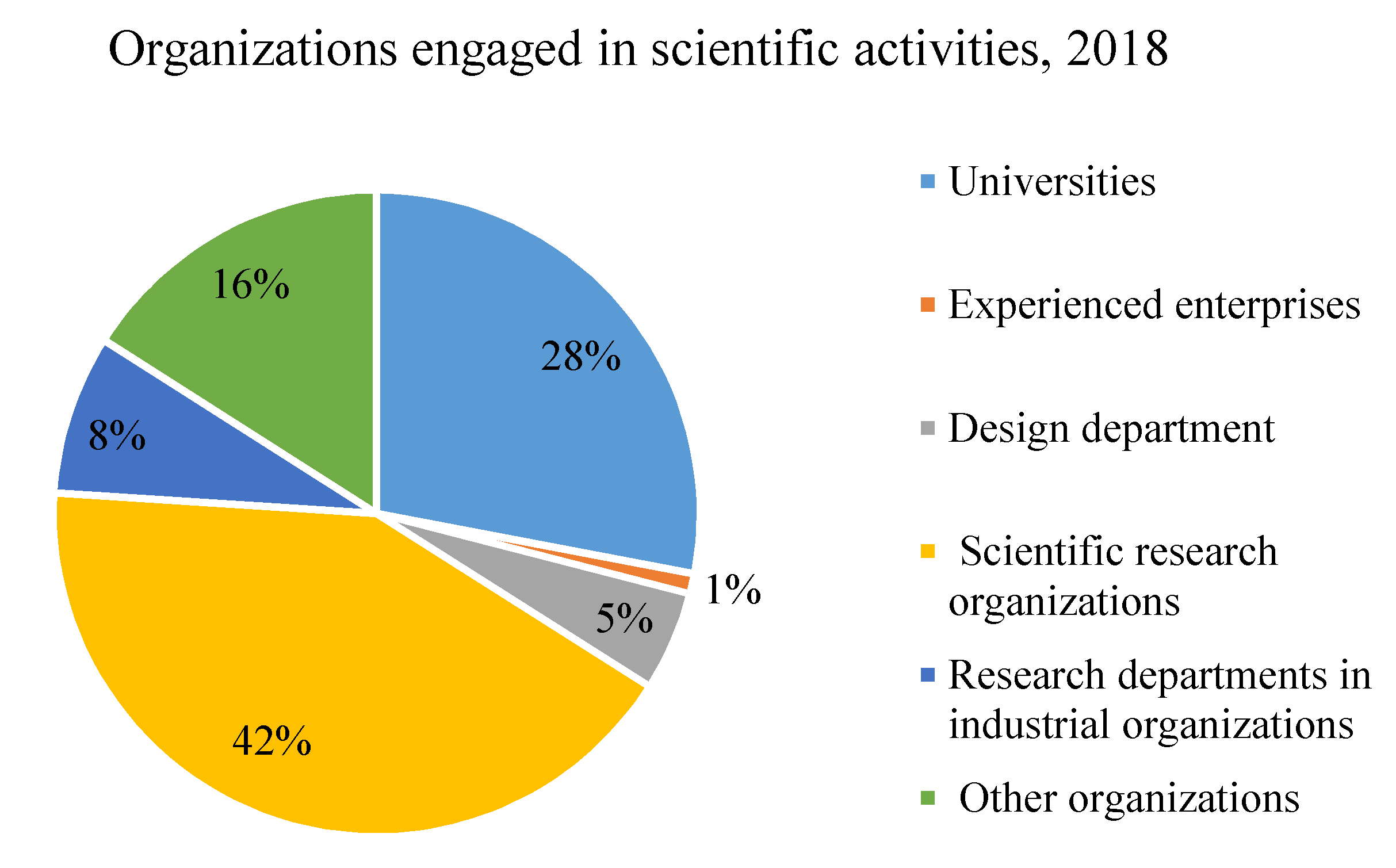
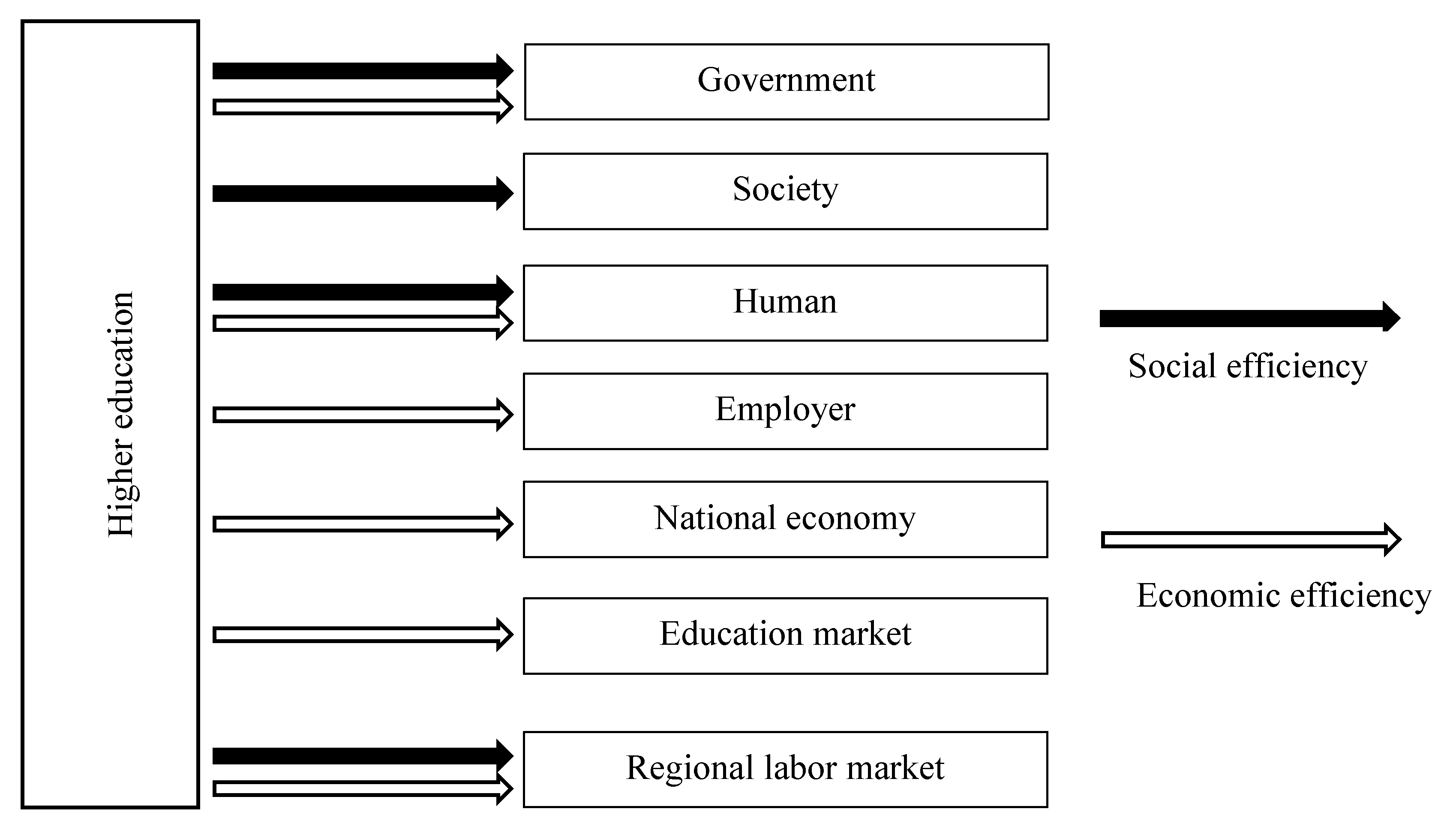
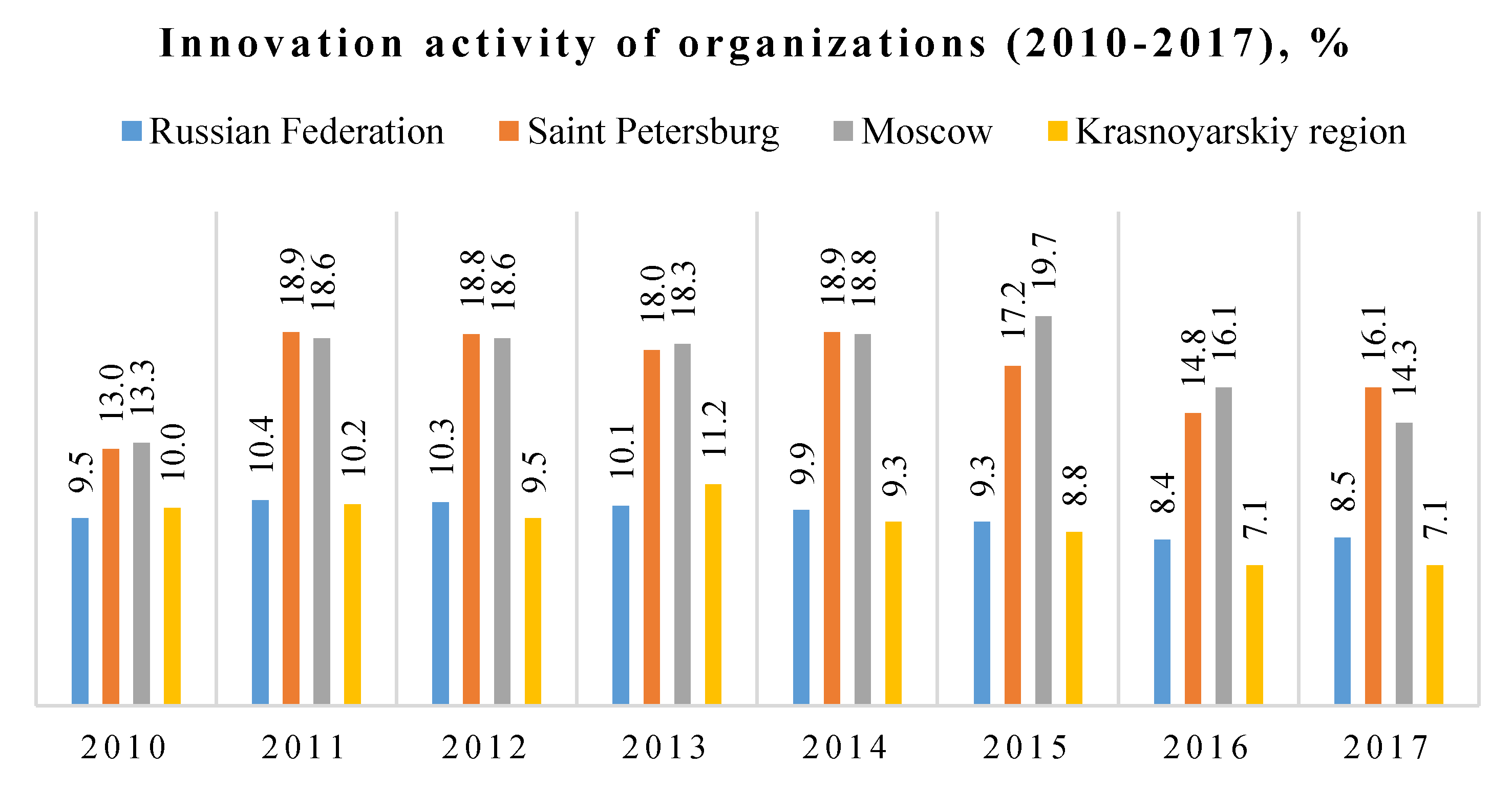
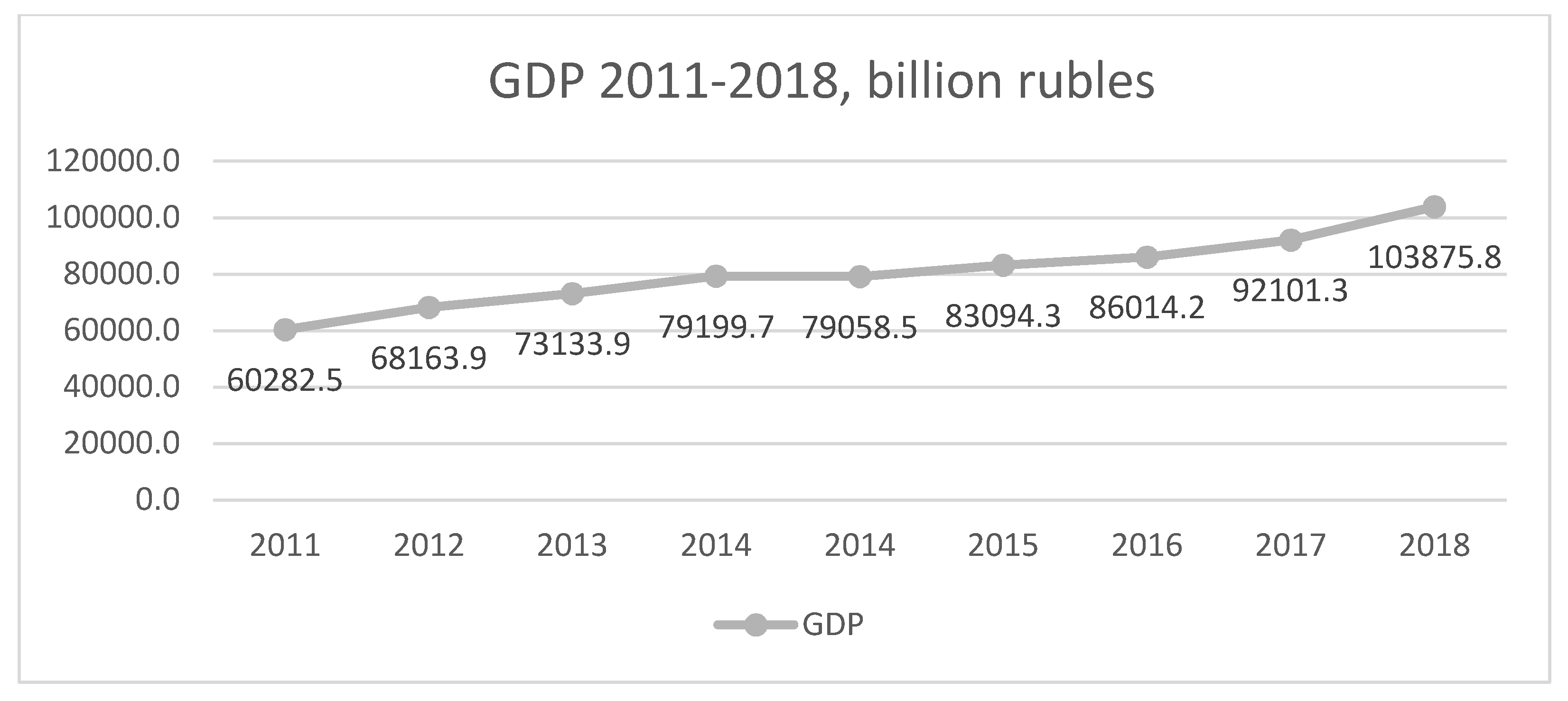
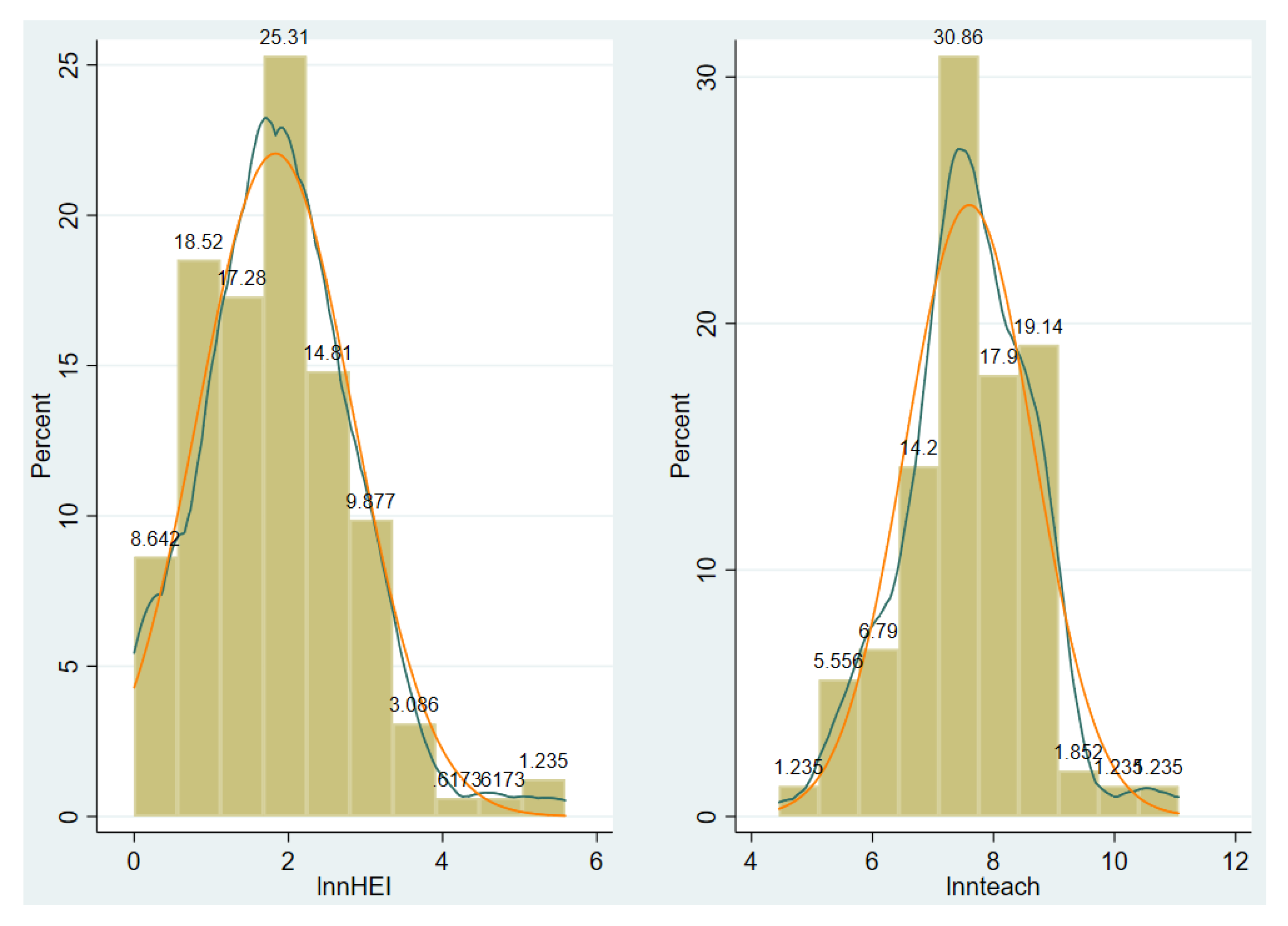
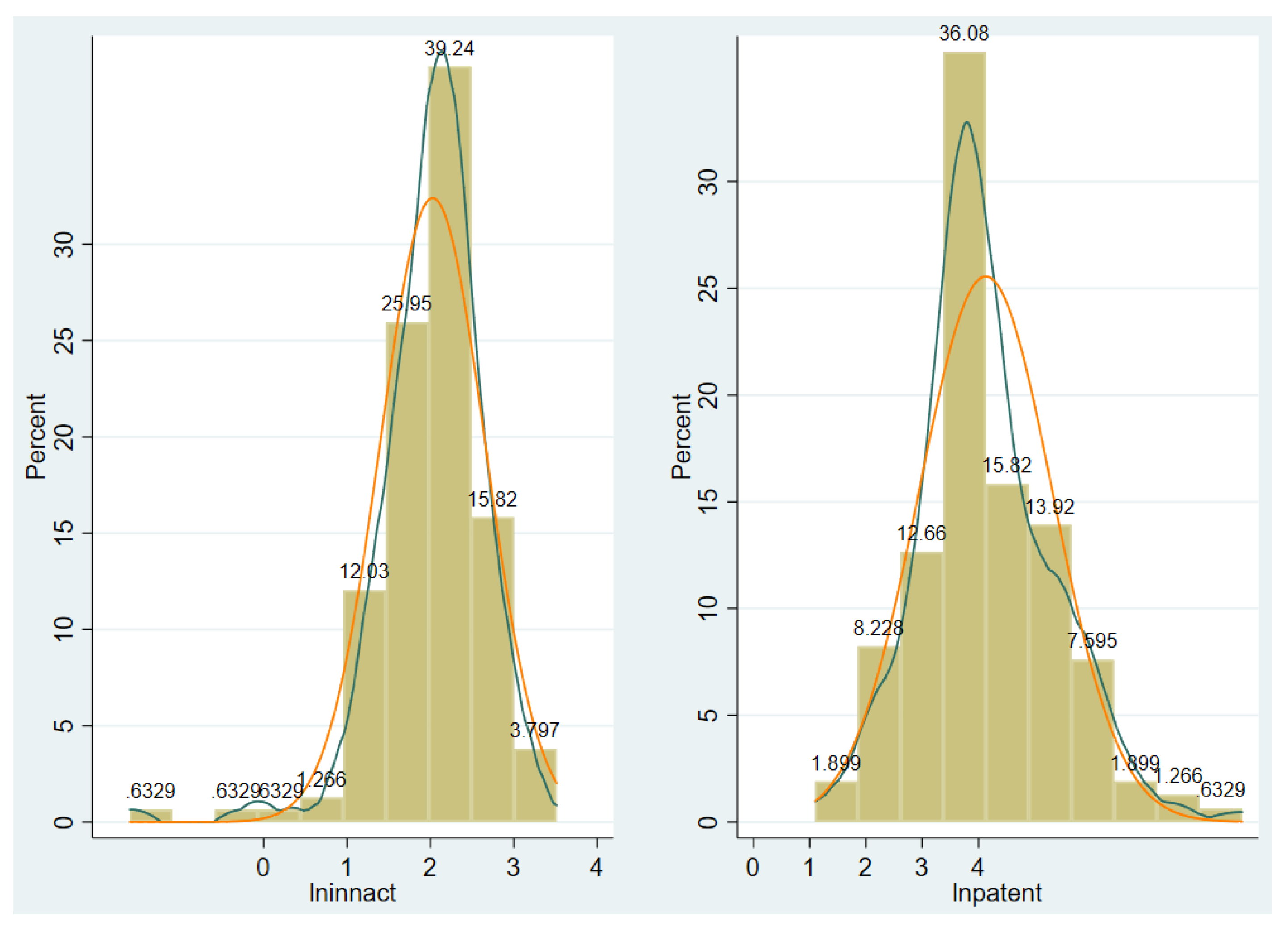
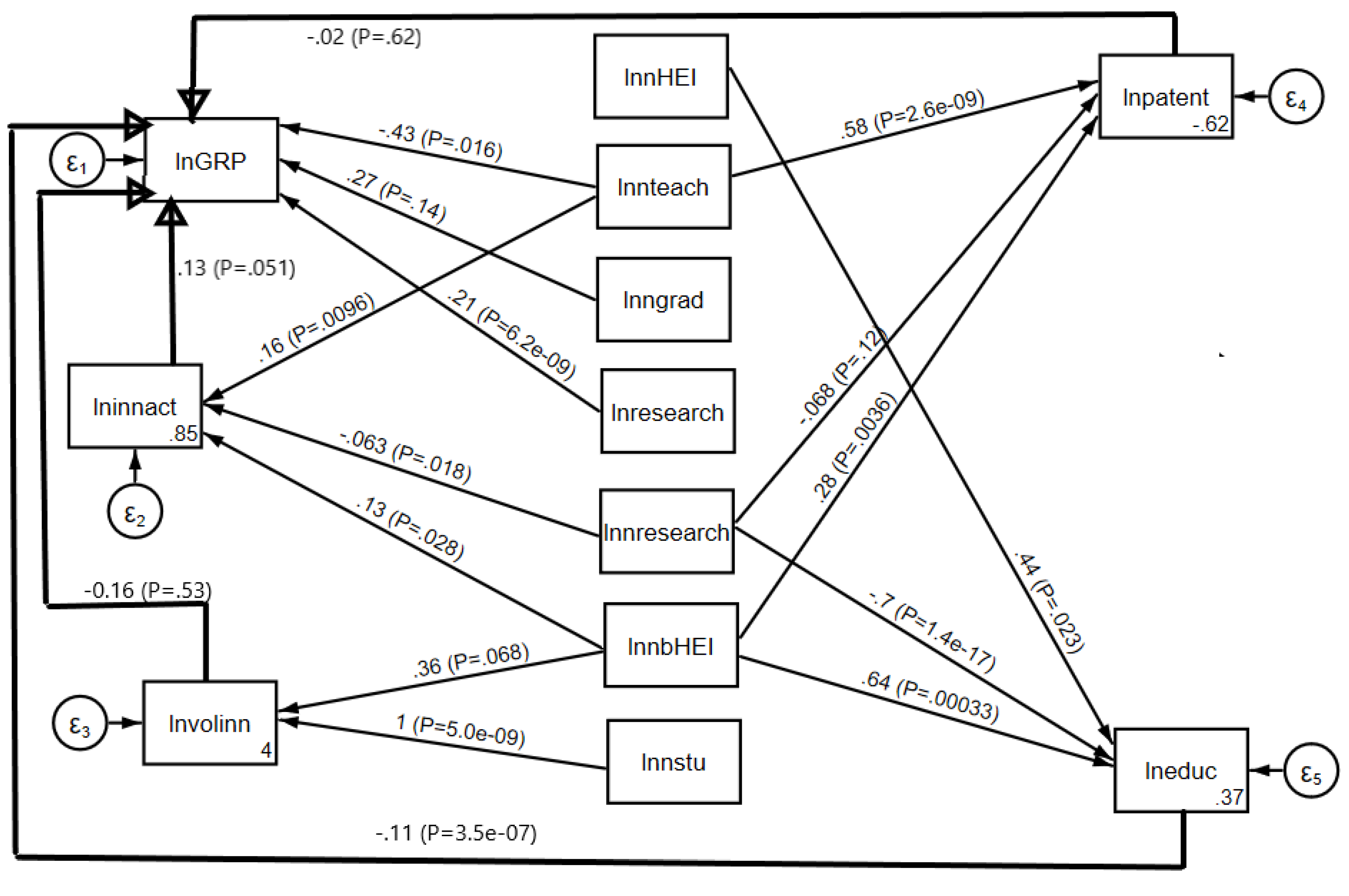
| Commercialization and Dissemination of Knowledge | Regional Development |
|---|---|
| Joint research; Contract research; Consulting; Establishment of enterprises (start-ups and spin-offs); Patenting and licensing; Additional educational programs on professional development; Joint publishing activity with partner companies. | Employment of graduates in the region; Practitioners and internships for students and university staff at regional enterprises; Applicants from the region who entered the university; Events organized by the university, as well as events in which the university participates (exhibitions, conferences, workshops, etc.). |
| Input (2011) | Output (2018) |
|---|---|
| Number of educational institutions of higher education (nHEI), units | Gross regional product per capita (GRP), million rubles |
| Number of branches of educational organizations of higher education (nbHEI), units | Innovative activity of organizations (innact), share % |
| Number of faculty teaching under the bachelor’s, master’s, and specialty programs (nteach), units | Volume of innovative goods and services (volinn), million rubles |
| Number of students enrolled in undergraduate, graduate, and specialist programs (nstu), person | Patent filing (patent), share % |
| Graduation with bachelor’s, master’s, and specialist degrees (ngrad), thousands of people | |
| Number of researchers with a degree by region (nresearch), person | The share of education in the sectoral structure of GRP (educ), share % |
| The number of costs for research and development (research), million rubles |
| Mean | Median | Skewness | Kurtosis | St. Dev. | |
|---|---|---|---|---|---|
| nHEI | 11.188 | 6.000 | 7.676 | 71.150 | 25.307 |
| nbHEI | 14.112 | 9.000 | 3.212 | 17.986 | 16.513 |
| nteach | 3515.471 | 1815.000 | 6.413 | 50.974 | 6722.172 |
| nstu | 66.390 | 39.750 | 6.662 | 58.812 | 113.935 |
| ngrad | 14.439 | 7.600 | 6.823 | 57.829 | 27.598 |
| nresearch | 1078.598 | 166.500 | 8.029 | 70.249 | 4972.990 |
| research | 12,008.580 | 1768.500 | 6.665 | 51.685 | 42,865.590 |
| Mean | Median | Skewness | Kurtosis | St. Dev. | |
|---|---|---|---|---|---|
| GRP | 403,000 | 262,662 | 6.214 | 51.433 | 582,000 |
| innact | 8.686 | 7.900 | 1.446 | 6.872 | 4.925 |
| volinn | 32,088.560 | 7239.950 | 3.519 | 17.091 | 66,297.820 |
| patent | 147.382 | 47.729 | 10.107 | 117.459 | 488.383 |
| educ | 1.946 | 0.088 | 1.289 | 5.225 | 2.335 |
| Input (2011) | After Logarithm | Output (2018) | After Logarithm |
|---|---|---|---|
| Number of educational institutions of higher education (nHEI), units | lnnHEI | Gross regional product per capita (GRP), million rubles | |
| Number of branches of educational organizations of higher education (nbHEI), units | lnnbHEI | Innovative activity of organizations (innact), share % | lninnact |
| Number of faculty teaching under the bachelor’s, master’s, and specialty programs (nteach), units | lnnteach | Volume of innovative goods and services (volinn), million rubles | lnvolinn |
| Number of students enrolled in undergraduate, graduate, and specialist programs (nstu), person | lnnstu | Patent filing (patent), share % | lnpatent |
| Graduation with bachelor’s, master’s, and specialist degrees (ngrad), thousands of people | lnngrad | ||
| Number of researchers with Φ degree by region (nresearch), person | lnnresearch | The share of education in the sectoral structure of GRP (educ), share % | lneduc |
| The volume of costs for research and development (research), million rubles | lnresearch |
| Mean | Median | Skewness | Kurtosis | St. Dev. | |
|---|---|---|---|---|---|
| lnnHEI | 1.831 | 1.792 | 0.405 | 3.926 | 1.012 |
| lnnbHEI | 2.261 | 2.303 | −0.218 | 2.911 | 0.989 |
| lnnteach | 7.476 | 7.516 | −1.355 | 8.726 | 1.314 |
| lnnstu | 3.623 | 3.723 | −0.676 | 5.556 | 1.147 |
| lnngrad | 2.077 | 2.067 | −0.003 | 3.515 | 1.083 |
| lnnresearch | 4.886 | 5.170 | −0.139 | 3.256 | 2.062 |
| lnresearch | 7.657 | 7.561 | 0.143 | 3.166 | 1.833 |
| Mean | Median | Skewness | Kurtosis | St. Dev. | |
|---|---|---|---|---|---|
| lnGRP | 12.583 | 12.493 | 1.251 | 5.802 | 0.691 |
| lninnact | 2.014 | 2.073 | −1.539 | 9.690 | 0.626 |
| lnvolinn | 8.529 | 8.895 | −0.725 | 3.497 | 2.455 |
| lnpatent | 4.129 | 3.948 | 0.568 | 4.064 | 1.185 |
| lneduc | −0.973 | −2.253 | 0.019 | 1.154 | 2.273 |
| Region | Efficiency | |
|---|---|---|
| Belgorod region | 0.123 | |
| Bryansk region | 0.578 | |
| Vladimir region | 0.050 | |
| Voronezh region | 0.017 | |
| Ivanovo region | 0.020 | |
| Kaluga region | 0.042 | |
| Kostroma region | 0.274 | |
| Kursk region | 0.033 | |
| Lipetsk region | 0.155 | |
| Moscow region | 1.000 | |
| Oryol Region | 0.105 | |
| Ryazan Oblast | 0.092 | |
| Smolensk region | 0.085 | |
| Tambov Region | 0.061 | |
| Tver region | 0.047 | |
| Tula region | 0.113 | |
| Yaroslavskaya oblast | 0.064 | |
| Moscow | 1.000 | |
| Republic of Karelia | 0.308 | |
| Komi Republic | 0.019 | |
| Nenets Autonomous Okrug | 1.000 | |
| Arkhangelsk region | 1.000 | |
| Vologodskaya Oblast | 0.361 | |
| Kaliningrad region | 0.076 | |
| Leningrad region | 0.721 | |
| Murmansk region | 0.042 | |
| Novgorod region | 0.072 | |
| Pskov region | 0.245 | |
| Saint Petersburg | 1.000 | |
| Republic of Adygea | 1.000 | not analyzed |
| Republic of Kalmykia | 0.111 | |
| Republic of Crimea | 1.000 | not analyzed |
| Krasnodar region | 0.058 | |
| Astrakhan region | 0.037 | |
| Volgograd region | 0.042 | |
| Rostov region | 0.029 | |
| Sevastopol | 1.000 | not analyzed |
| The Republic of Dagestan | 0.009 | |
| The Republic of Ingushetia | 0.011 | |
| Kabardino-Balkarian Republic | 0.058 | |
| Karachay-Cherkess Republic | 0.163 | |
| Republic of North Ossetia—Alania | 0.116 | |
| Chechen Republic | 0.227 | |
| Stavropol region | 0.029 | |
| Republic of Bashkortostan | 0.043 | |
| Mari El Republic | 0.544 | |
| The Republic of Mordovia | 1.000 | |
| Republic of Tatarstan | 1.000 | |
| Udmurt republic | 0.596 | |
| Chuvash Republic | 0.120 | |
| Perm region | 1.000 | |
| Kirov region | 0.178 | |
| Nizhny Novgorod Region | 0.085 | |
| Orenburg region | 0.050 | |
| Penza region | 0.040 | |
| Samara Region | 0.079 | |
| Saratov region | 0.078 | |
| Ulyanovsk region | 0.041 | |
| Kurgan region | 0.434 | |
| Sverdlovsk region | 0.062 | |
| Tyumen region | 0.811 | |
| Khanty-Mansi Autonomous Okrug—Ugra | 0.300 | |
| Yamal-Nenets Autonomous Okrug | 1.000 | not analyzed |
| Chelyabinsk region | 0.371 | |
| Altai Republic | 0.018 | |
| The Republic of Buryatia | 0.066 | |
| Tyva Republic | 0.026 | |
| The Republic of Khakassia | 0.512 | |
| Altai region | 0.143 | |
| Transbaikal region | 0.110 | |
| Krasnoyarsk region | 0.331 | |
| Irkutsk region | 0.053 | |
| Kemerovo region | 0.070 | |
| Novosibirsk region | 0.019 | |
| Omsk region | 0.056 | |
| Tomsk region | 0.014 | |
| The Republic of Sakha (Yakutia) | 0.175 | |
| Kamchatka Krai | 0.433 | |
| Primorsky Krai | 0.024 | |
| Khabarovsk region | 0.643 | |
| Amurskaya Oblast | 1.000 | |
| Magadan Region | 1.000 | |
| Sakhalin Oblast | 0.453 | |
| Jewish Autonomous Region | 0.011 | |
| Chukotka Autonomous Okrug | 1.000 | not analyzed |
| m1 | m2 | m3 | m4 | m5 | m0 | |
|---|---|---|---|---|---|---|
| b/se | b/se | b/se | b/se | b/se | b/se | |
| lnGRP | ||||||
| lnnteach | 2.000 *** | 1.927 *** | ||||
| (0.055) | (0.055) | |||||
| lnngrad | −2.328 *** | −2.118 *** | ||||
| (0.089) | (0.088) | |||||
| lnresearch | 0.296 *** | 0.228 *** | ||||
| (0.054) | (0.055) | |||||
| lninnact | 0.258 *** | |||||
| (0.099) | ||||||
| lnpatent | 0.046 | |||||
| (0.059) | ||||||
| lneduc | −0.108 *** | |||||
| (0.031) | ||||||
| lnvolinn | −0.025 | |||||
| (0.039) | ||||||
| _cons | 0 | 0 | ||||
| lninnact | ||||||
| lnnteach | 0.284 *** | 0.284 *** | ||||
| (0.028) | (0.028) | |||||
| lnnresearch | 0.094 | −0.063 *** | ||||
| (0.059) | (0.027) | |||||
| lnnbHEI | −0.076 *** | 0.094 | ||||
| (0.027) | (0.058) | |||||
| _cons | 0 | 0 | ||||
| lnpatent | ||||||
| lnnteach | 0.488 *** | 0.488 *** | ||||
| (0.046) | (0.046) | |||||
| lnnresearch | 0.307 *** | −0.068 | ||||
| (0.096) | (0.043) | |||||
| lnnbHEI | −0.061 | 0.307 *** | ||||
| (0.044) | (0.095) | |||||
| _cons | 0 | 0 | ||||
| lneduc | ||||||
| lnnresearch | −0.676 *** | −0.661 *** | ||||
| (0.062) | (0.062) | |||||
| lnnbHEI | 0.618 *** | 0.718 *** | ||||
| (0.166) | (0.145) | |||||
| lnnHEI | 0.018 | 0.418 *** | ||||
| (0.372) | (0.192) | |||||
| _cons | 0 | 0 | ||||
| lnvolinn | ||||||
| lnnbHEI | 0.467 *** | 0.467 *** | ||||
| (0.232) | (0.231) | |||||
| lnnstu | 1.974 *** | 1.974 *** | ||||
| (0.149) | (0.148) | |||||
| _cons | 0 | 0 | ||||
| var(e.lnGRP) | 0.398 *** | |||||
| (0.046) | (0.046) | |||||
| var(e.lninnact) | 0.357 *** | |||||
| (0.040) | (0.040) | |||||
| var(e.lnpatent) | 0.894 *** | |||||
| (0.102) | (0.102) | |||||
| var(e.lneduc) | 2.996 *** | |||||
| (0.343) | (0.343) | |||||
| var(e.lnvolinn) | 5.002 *** | |||||
| (0.563) | (0.563) | |||||
| N | 159 | 156 | 158 | 153 | 153 | 159 |
| ll | −190.069 | −141.001 | −351.374 | −208.487 | −300.237 | −1142.780 |
| aic | 386.138 | 288.002 | 706.747 | 422.973 | 608.473 | 2331.559 |
| bic | 395.344 | 297.152 | 712.873 | 432.065 | 620.595 | 2402.144 |
| r2 | 0.996 | 0.921 | 0.938 | 0.952 | 0.489 | |
Publisher’s Note: MDPI stays neutral with regard to jurisdictional claims in published maps and institutional affiliations. |
© 2020 by the authors. Licensee MDPI, Basel, Switzerland. This article is an open access article distributed under the terms and conditions of the Creative Commons Attribution (CC BY) license (http://creativecommons.org/licenses/by/4.0/).
Share and Cite
Rodionov, D.; Velichenkova, D. Relation between Russian Universities and Regional Innovation Development. J. Open Innov. Technol. Mark. Complex. 2020, 6, 118. https://doi.org/10.3390/joitmc6040118
Rodionov D, Velichenkova D. Relation between Russian Universities and Regional Innovation Development. Journal of Open Innovation: Technology, Market, and Complexity. 2020; 6(4):118. https://doi.org/10.3390/joitmc6040118
Chicago/Turabian StyleRodionov, Dmitrii, and Daria Velichenkova. 2020. "Relation between Russian Universities and Regional Innovation Development" Journal of Open Innovation: Technology, Market, and Complexity 6, no. 4: 118. https://doi.org/10.3390/joitmc6040118
APA StyleRodionov, D., & Velichenkova, D. (2020). Relation between Russian Universities and Regional Innovation Development. Journal of Open Innovation: Technology, Market, and Complexity, 6(4), 118. https://doi.org/10.3390/joitmc6040118





